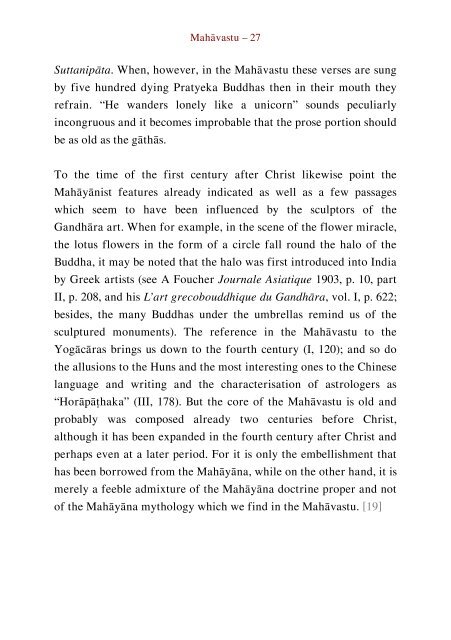Literary History of Sanskrit Buddhism
A study by J. K. Nariman of Sanskrit Buddhism from the Early Buddhist Tradition up to the Mahayana texts proper.
A study by J. K. Nariman of Sanskrit Buddhism from the Early Buddhist Tradition up to the Mahayana texts proper.
Create successful ePaper yourself
Turn your PDF publications into a flip-book with our unique Google optimized e-Paper software.
Mahāvastu – 27<br />
Suttanipāta. When, however, in the Mahāvastu these verses are sung<br />
by five hundred dying Pratyeka Buddhas then in their mouth they<br />
refrain. “He wanders lonely like a unicorn” sounds peculiarly<br />
incongruous and it becomes improbable that the prose portion should<br />
be as old as the gāthās.<br />
To the time <strong>of</strong> the first century after Christ likewise point the<br />
Mahāyānist features already indicated as well as a few passages<br />
which seem to have been influenced by the sculptors <strong>of</strong> the<br />
Gandhāra art. When for example, in the scene <strong>of</strong> the flower miracle,<br />
the lotus flowers in the form <strong>of</strong> a circle fall round the halo <strong>of</strong> the<br />
Buddha, it may be noted that the halo was first introduced into India<br />
by Greek artists (see A Foucher Journale Asiatique 1903, p. 10, part<br />
II, p. 208, and his L’art grecobouddhique du Gandhāra, vol. I, p. 622;<br />
besides, the many Buddhas under the umbrellas remind us <strong>of</strong> the<br />
sculptured monuments). The reference in the Mahāvastu to the<br />
Yogācāras brings us down to the fourth century (I, 120); and so do<br />
the allusions to the Huns and the most interesting ones to the Chinese<br />
language and writing and the characterisation <strong>of</strong> astrologers as<br />
“Horāpāṭhaka” (III, 178). But the core <strong>of</strong> the Mahāvastu is old and<br />
probably was composed already two centuries before Christ,<br />
although it has been expanded in the fourth century after Christ and<br />
perhaps even at a later period. For it is only the embellishment that<br />
has been borrowed from the Mahāyāna, while on the other hand, it is<br />
merely a feeble admixture <strong>of</strong> the Mahāyāna doctrine proper and not<br />
<strong>of</strong> the Mahāyāna mythology which we find in the Mahāvastu. [19]


















